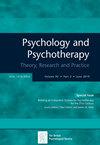Associations between treatment credibility, patient expectancies, working alliance and symptom trajectory in cognitive behaviour therapy for pathological health anxiety
Abstract
Objectives
To evaluate how treatment credibility, the expectancy of improvement and the relationship with the therapist (the working alliance) change in relation to symptoms in cognitive behaviour therapy (CBT) for pathological health anxiety.
Design
Secondary study of a randomised controlled trial of Internet-delivered (n = 102) and face-to-face CBT (n = 102) for health anxiety.
Methods
The trial was conducted at a primary health care clinic in Stockholm, Sweden, between December 2014 and July 2018. Both treatments lasted 12 weeks. Health anxiety was measured using the 18-item Health Anxiety Inventory. Credibility/expectancy (Borkovec credibility/expectancy scale) and the strength of the working alliance (Working Alliance Inventory) were self-reported by the participant at weeks two and eight. Symptom slopes from a linear mixed model were related to these process scales.
Results
Correlations between the process variables (credibility/expectancy, working alliance) and the overall, 12-week pre- to post-treatment, reduction in health anxiety were small to moderate, and slightly higher based on data from week 8 (rs = 0.33–0.41) than week 2 (rs = 0.17–0.29). In the whole sample, week 2 credibility/expectancy and working alliance were significant predictors of subsequent symptom reduction. In secondary subgroup analyses, the process variables predicted improvement in Internet-delivered CBT, but not in face-to-face CBT. Direct between-format tests were not significant. Week 8 credibility/expectancy and working alliance were more closely related to previous than subsequent symptom reduction.
Conclusions
The patient's early ratings of credibility/expectancy and the strength of the working alliance appear to be predictive of subsequent symptom reduction. Later ratings appear to be of more limited predictive utility.





 求助内容:
求助内容: 应助结果提醒方式:
应助结果提醒方式:


